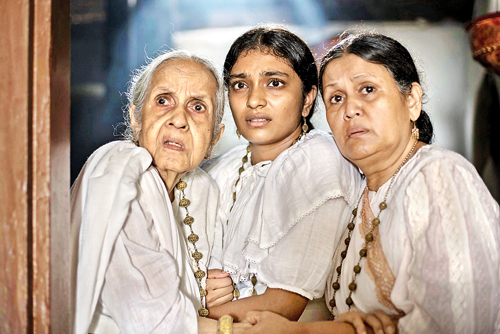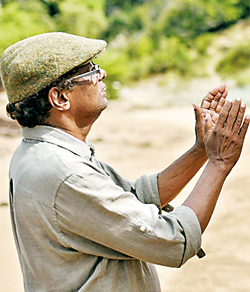It’s far from ‘The End’

Still awaiting release: Prasanna Vithanage’s ‘Gaadi’ - from left:Iranganie Serasinghe, Dinara Punchihewa and Damayanthi Fonseka in a scene from the film
How do you market and release a film during a pandemic? Last year, Visakesa Chandrasekaram’s second movie Paangshu, completed in February 2018 and premiered at international film festivals took two and a half years to navigate its national release. The pandemic then paused its release further. When cinemas opened up after the first round of lockdowns, Visakesa seized this small window and decided to launch the movie, aware it was a risky move, that moviegoers were few and that his work was for a niche audience.
“In an ordinary time, I would have had maybe 15 cinemas and would have had to compete for screen time. But we ended up getting more than 30 cinemas, over 50 days of running in some theatres and more media exposure than we imagined,” he reflects. “What I realized was that making a movie is not only getting people to watch it but to also talk about it.” A 40-minute post-movie discussion in Gampaha turned into a one and a half-hour animated (and at times heated) conversation with a large audience. It also meant cinema staff were employed.
It has been a hard time for cinemas. Visiting parts of the island last year to speak with theatre owners scheduled to screen his movie Gaadi (Children of the Sun), Prasanna Vithanage found many struggling to survive. Shows were cancelled due to no audiences, many owners had taken out loans for digitalization and the loan moratoriums were reaching their expiry date.

Visakesa Chandrasekaram
Gaadi, set in 1814 Ceylon about two people from different social strata unwillingly brought together, had its European premiere in January 2020. But invitations for a few film festivals and a national release for this 25-year passion project crumbled as 2020 unfurled.
COVID-19 comes at a time when Sri Lanka’s film industry already faces numerous challenges. Over the past ten years, the number of movie patrons has decreased. 2009 saw a total of 8.6 million moviegoers for Sinhala, Tamil and English films across Sri Lanka. In 2019, this had dropped to 5.1 million. Data provided by the National Film Corporation also shows a reduction in the number of cinema screens around the island as a result of the pandemic – from 186 to 150 in mid-2020.
The battered industry has been advocating for relief measures such as calculating the electricity bills at a subsidized, industrial rate and the slashing of entertainment tax. In January 2021, the Prime Minister’s office announced the cinema industry was exempt from entertainment tax for 2021 and 2022.
While the introduction of multiplex theatres is aligned with cosmopolitan middle class aspirations, Prasanna points out that theatre-going in Sri Lanka tends to be expensive – especially for families – because of economic factors and infrastructure expenses such as transport, parking, ticket and food expenses intertwined with it. The industry was sustained by raising ticket prices. He wryly quotes an analogy by veteran filmmaker, the late D. B. Nihalsinghe: “We have been sucking blood from the patient.”

Ileka Ruwanpathirana
“The movie industry has been sustaining itself so far because of a few adventurous and passionate people producing and financing films,” he adds. With more people watching movies at home, and no clear finish line for the pandemic he wonders about the theatre-going habits of Sri Lankans in the long run.
While over-the-top (OTT) content platforms such as Netflix have seen a surge worldwide, in Sri Lanka the market is small. It is also a challenge for Sri Lankan creators to reach wider audiences through such international platforms. “For a Sri Lankan film, unless it gets international attention, it’s difficult to get into these markets. With this pandemic continuing and affecting theatre attendance – we will have to move to other platforms to recover investments and reach the audience,” notes Prasanna. YouTube has proved to be one way of connecting creators with new audiences – for instance, his docu-drama ‘Silence in the courts’ has now reached 286,000 views two months after its upload.
As the launch of Gaadi continues to be postponed, for lead actress Dinara Punchihewa, contending with the pandemic has been an exercise in hope, frustration but also gratitude. Gaadi was her long-awaited debut film. And while it’s been frustrating to see it postponed, she is grateful for work in a time of uncertainty. She recently completed a shoot for a film by Sanjeewa Pushpakumara and is scheduled to shoot two more Sri Lankan films this year. Saho (The Comrade), a film by Prof. Ariyarathna Athugala where Dinara plays the lead, completed a quarter of its shooting after the first lockdown amidst the new conditions.

Prasanna Vithanage
Ileka Ruwanpathirana, a lecturer with the Department of Mass Communication, University of Kelaniya and an Executive Producer who worked on the set of Saho explained how the pandemic posed numerous logistical challenges during filming. Film schedules and budgets had to be revised to accommodate delays and new health regulations. Locations paid for months in advance and that were non-refundable, had to be secured again. A picketing scene in the movie initially envisioned with 150 people, roadblocks, water bowsers and teargas was shot with 10 – 15 people, the camera gaze restricted to tight, close-ups instead of long, wide shots.
The lively film set banter, multiple interactions and camaraderie is limited too, says Ileka and health restrictions have inevitably slowed down working and production speeds.
The pandemic has also sharpened labour inequities and the lack of social protection and employment benefits. “In other professions, people are entitled to benefits such as EPF/ETF but in this industry everyone is freelance and there is nobody who bears responsibility,” says Ileka.
Loan schemes were offered last year for some within the cinema industry but this is a short term panacea. The pandemic has revealed a dire need for professionalism in the industry, standardized pay scales and employment protection for daily wage earners who are now in a dire state due to less work.
The promotion of Sri Lanka as a destination for international productions too is badly hit. The Film Team specializes in location scouting, set design and construction and production requirements for international productions filming in Sri Lanka and has provided services for movies like Midnight’s Children and Bombay Velvet. “Before the pandemic, we were fighting the odds because of the Easter attacks and 2019 brought us into a bleak period,” explains Gopi Darmaratnam, Director – Sales and Marketing at The Film Team. When a country is hit by a terror attack, insurance premiums increase and unless productions were based on stories set in Sri Lanka, many were unwilling to come to the country.
International productions have multiple spill-over benefits. International cast and crews’ stays contribute to the hospitality industry. Caterers, technicians for set construction and design, transport personnel and a crew of nearly 150 a day are a part of the creative apparatus. The technological expertise that comes in augments the skills of those working on these sets, explains Gopi. Many of them, daily wage earners and extras from nearby localities earn a higher remuneration than local industry standards offer.
While they had plans to promote film tourism targeting tourists from the UK with a Good Karma Hospital tour, a series popular in the UK and filmed in Sri Lanka, questions surface on how to move forward with COVID-19 numbers rising and the challenges of working within a bubble.
“We have not lost hope,” says Gopi. “We are trying to remain positive and keep our home fires burning. And at the end of the day, the safety of the country matters.”

International productions shot in Sri Lanka: The Film Team built this houseboat on the Koggala Lake for ‘The Good Karma Hospital’ filmed here
Yet although modes of consumption may shift, movies are here to stay for a while. Will the Sri Lankan film industry be able to withstand the changes, look to new marketing innovations, attract technical expertise and talent, and adapt to reach its audiences?
Visakesa notes a need for agility and dynamism within the industry: “This is the new reality, we have to live with it. We need action.” Opportunities such as offering Sri Lankan movies to its diaspora can be leveraged, he points out.
The pandemic also poses deeper, existential questions for the industry.
“After the pandemic, will it be the same world? Will it be the same Sri Lanka? With the economy going down and with the hardships people are undergoing, as artists we have to understand the scars of this. For many it has been a terrible experience. All over the world, the gap has widened. During the period of the war, we tried to understand people’s psyche and how the war affected people. Whether we will be able to bring out new changes in society and how these undercurrents have affected people and artistically portray it sincerely – that would be the real challenge,” says Prasanna.



